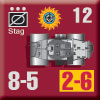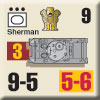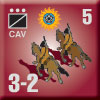| Panzer Grenadier: Indian Unity
Scenario Preview
By Mike Bennighof, Ph.D.
April 2015
It’s one of the joys of running a wargame publisher: bringing the players something completely new, the opportunity to play out a history they’ve never heard of before opening the game. Panzer Grenadier: Indian Unity hits that target perfectly. And now that it's receiving a full set of beautiful laser-cut-and-mounted playing pieces, it has become the fine product it always should have been.
The 165 counters put some great new pieces into play: the Hyderbadi Army with its armored cars, horsed cavalry and fanatic Razakar militia, and the Indian Army with Sherman tanks, horsed cavalry and an armored train. But the core of the supplement, like any Panzer Grenadier game, is the scenario set. There are ten scenarios, nine of them based on actual battles (the tenth is a hypothetical tank battle with the force the Nizam of Hyderabad hoped to equip). Here’s a look at the first half of them:
Scenario One
Provocation
6 September 1948
 Across the Deccan highlands that included the princely state of Hyderabad, Communist insurgents beheaded Muslim landlords and encouraged peasants to seize their land and form communes. In retaliation, a powerful Hyderabad politician, Qasim Razvi, formed a Muslim militia known as the Razakars. Razvi's men burned villages that had turned out their landlords and murdered those they thought might be communists. According to Indian accounts, a mob of Razakars crossed into Indian territory at the village of Chillakallu. The Indian Army then sent a force of tanks and Gurkhas to "investigate" the incident. Across the Deccan highlands that included the princely state of Hyderabad, Communist insurgents beheaded Muslim landlords and encouraged peasants to seize their land and form communes. In retaliation, a powerful Hyderabad politician, Qasim Razvi, formed a Muslim militia known as the Razakars. Razvi's men burned villages that had turned out their landlords and murdered those they thought might be communists. According to Indian accounts, a mob of Razakars crossed into Indian territory at the village of Chillakallu. The Indian Army then sent a force of tanks and Gurkhas to "investigate" the incident.
Note: This scenario uses a board from Eastern Front and pieces from Desert Rats.
Conclusion
The Razakars shot up the police station, and were still attacking the town when Indian infantry and tank reinforcements appeared. The militia fled back across the border into Hyderabad with the Indians in hot pursuit, leaving a number of dead police and militants behind.
Notes
This is a small scenario, the biggest clash during the tensions leading up to the Hundred Hour War. A huge mob of Razakar militia storm a town held by Indian police, who have to hold out until rescue arrives in the form of a mixed force of Indian tanks and Gurkha riflemen. The Razakars don’t have much of a chance against the regulars, so they need to force the issue quickly, whatever the cost.
Scenario Two
Over the Line
6 September 1948
The Indian Army force's pursuit of the Razakar militia over the border brought them into contact with Hyderabad's regular army. The Indians would later contend that the Hyderabadis had full knowledge of the Razakar raid; the Hyderabadis never had an opportunity to confirm or deny the charge. In any event, when the Indians ran into a regular Hyderabad force, fighting immediately broke out.
Note: This scenario uses boards from Eastern Front.
Conclusion
The Indian tankers chased the Razakars over the border, leaving their infantry support behind in their frenzy to run down the Muslims. Once they crossed the border they found the Hyderabadis more than willing to fight: Kodad lay along the main highway to the Nizam's capital and the local garrison appears to have interpreted the action as a sneak attack. The Hyderabad "armor" regiments only fielded armored cars, however, and they got the worst of the action with the Indian Shermans.
Notes
An unusual scenario, the Indians storm onto the board with a small force of unsupported Shermans, to root out hidden Razakar militia. There’s also a small force of Hyderabadi regulars with a 6-pounder anti-tank gun that can hurt the tanks if it gets a clear shot, and a strong group of armored cars that come into play immediately as well. The Indians will eventually get some infantry support, and that can turn the tide as the tanks no longer need to fear ambush in the woods.
Scenario Three
Naldurg Fort
13 September 1948
 The Indian Army staff laid out an ambitious two-pronged invasion of Hyderabad, over the strenuous objections of army commander-in-chief Sir Roy Bucher. Bucher, a British officer left over from the colonial administration, warned Prime Minister Jawaharlal Nehru and his cabinet that starting a war with Hyderabad while Pakistan's stance in the ongoing Kashmir crisis remained unclear would be extremely dangerous. Nehru insisted the invasion go forward and Bucher angrily resigned, accusing the Indian politicians of strategic stupidity and moral cowardice, and of forgetting Gandhi's principles less than a year after the Mahatma's death. The first obstacle met by the invaders would be the massive, aged masonry fort at Naldurg. The Indian Army staff laid out an ambitious two-pronged invasion of Hyderabad, over the strenuous objections of army commander-in-chief Sir Roy Bucher. Bucher, a British officer left over from the colonial administration, warned Prime Minister Jawaharlal Nehru and his cabinet that starting a war with Hyderabad while Pakistan's stance in the ongoing Kashmir crisis remained unclear would be extremely dangerous. Nehru insisted the invasion go forward and Bucher angrily resigned, accusing the Indian politicians of strategic stupidity and moral cowardice, and of forgetting Gandhi's principles less than a year after the Mahatma's death. The first obstacle met by the invaders would be the massive, aged masonry fort at Naldurg.
Note: This scenario uses boards from Eastern Front and Road to Berlin, and pieces from Cassino �44.
Conclusion
The Hyderabadis had been alerted to the coming invasion (probably thanks to the constantly raiding Razakars), yet when the Indians came the princely troops proved unable to stop them. An Indian flying column seized the bridge without opposition, capturing a British mercenary charged with blowing it up before he could set off his charges. With the bridge taken and the Indians streaming past and unimpressed by the fire of a Hyderabadi 25-pounder battery ensconced behind the crumbling walls, the Nizam's men abandoned the fort during the day.
Notes
This is a big scenario, with two full Indian infantry battalions and some support units advancing against a full Hyderabadi battalion backed by an equal number of Razakar militia and one of the few modern 25-pounder batteries in the Nizam’s armory. The Indians have to take a bridge and a large fort from the Hyderabadis, while the Nizam’s men have to hold them.
Scenario Four
Hyderabad Lancers
13 September 1948
On Hyderabad's eastern border, the weaker of the Indian pincers met the strongest Hyderabadi forces, who expected the main effort to come on this front. The Indians surged up the same highway they'd used to attack Kodad a week earlier, with much greater force. But the Nizam's army had deployed its best units here to stop the Indians at any cost.
Note: This scenario uses boards from Eastern Front and pieces from Cassino �44.
Conclusion
The Hyderabad Lancers had seen action in the Middle East under British command, and this veteran unit put up fierce resistance to the Indian invaders. The Razakars fought desperately as well, but the Hyderabad troops had few weapons capable of stopping the Indian Shermans and eventually the defenders had to fall back.
 Notes Notes
Another fairly big scenario, this is the climactic armored battle of the Hundred Hour War. Unfortunately for the Hyderabadis, it’s an “armored battle” and not a “tank battle,” as they wield Staghound and Humber armored cars against the Indian Shermans. Both sides have strong infantry forces as well, and the Hyderabadis bring their usual cloud of Razakar fanatics as well. The burden of attack is on the Indians, with a long list of objectives and not a lot of time to take the
Scenario Five
The Sugar Factory
13 September 1948
The Indian Army's invasion plan rejected an invasion from the south, since no gains made there would force the Nizam's surrender. The local commander, Brigadier N.V. Bal, objected to this omission and ordered his eclectic collection of troops forward anyway. At the town of Hospet, they ran into determined defenders occupying a sugar factory dominating a river crossing.
Note: This scenario uses a board from Road to Berlin and pieces from Cassino �44.
Conclusion
The Mysore infantry became pinned down under Hyderabadi fire and berserk close assaults by sword-wielding Razakars. Bal committed more and more of his forces, which included an armored train and the Indian Army's only remaining horsed cavalry regiment. Twice the Indians took the sugar factory only to be ejected again by Hyderabadi assaults. Seizing it a third time, they finally managed to fight off the Nizam's troops.
 Notes Notes
This battle is the real reason I designed Indian Unity. The Hyderabadis are dug in, and the Indians have to eject them from their prepared positions. There’s not a lot of leeway for the Indian player: he’s violating his orders by launching this attack, so even middling success will get him cashiered or worse. He has to win and win big. And to do so, he gets the Indian Army’s lone remaining regiment of horsed cavalry plus an armored train.
Mike Bennighof is president of Avalanche Press and holds a doctorate in history from Emory University. A Fulbright Scholar and award-winning journalist, he has published over 100 books, games and articles on historical subjects.
He lives in Birmingham, Alabama with his wife, three children and his dog, Leopold.
|
